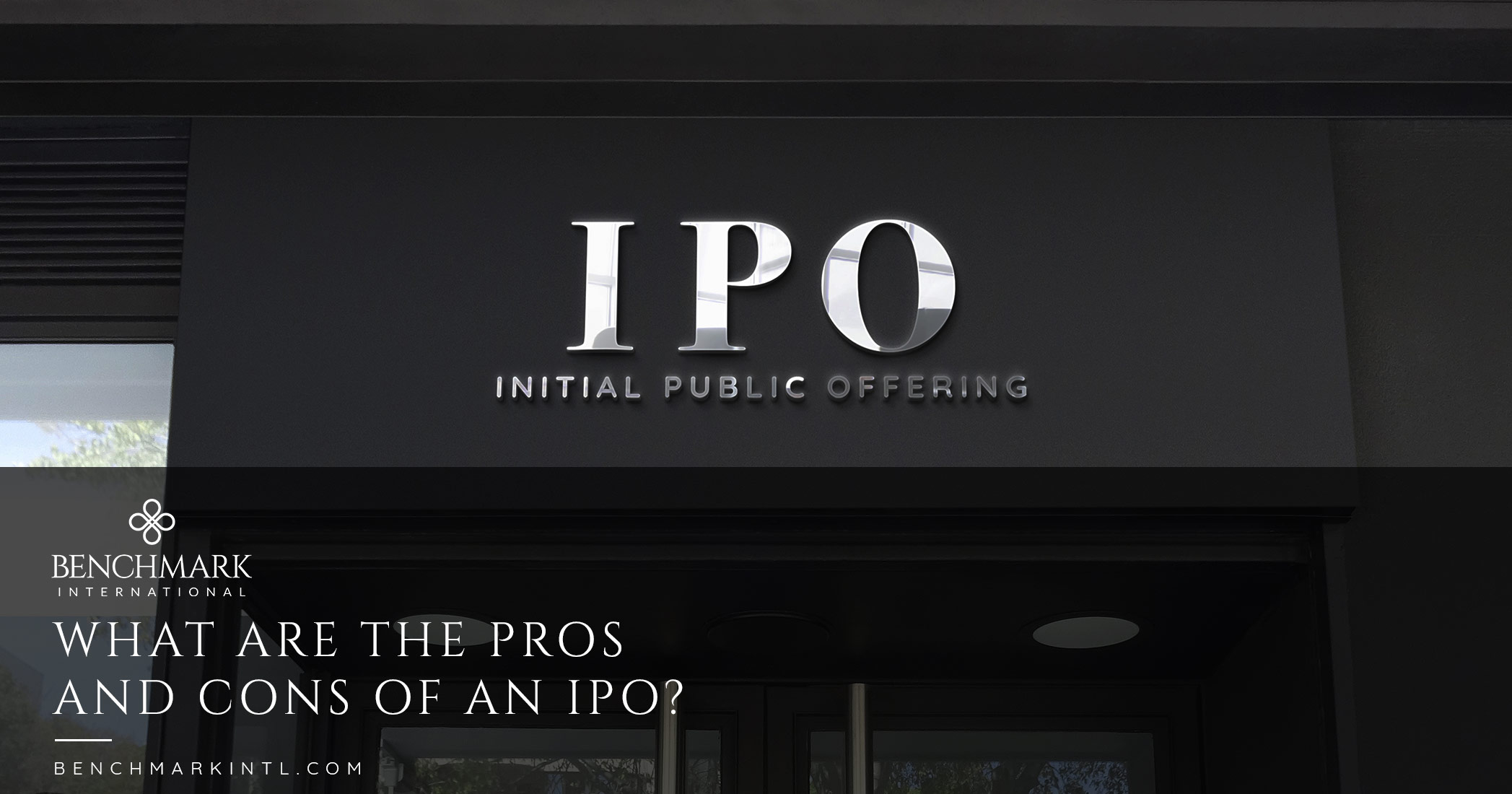If you have ever taken a family road trip, you understand the necessity of planning in advance. Navigation systems and GPS have made it easier, but advanced planning will make the journey more enjoyable. The most important decision is what is the intended destination. Once that is determined, there are a whole series of decisions that must be made, either in advance or along the way, to reach that ultimate vacation spot. The questions include which car we should drive, what roads we should take, how fast we can drive, whether we should pack a cooler or eat at restaurants along the way, what our budget is, and where we will stay.
READ MORE >>Archives
Road Trip!
What Are The Pros And Cons Of An IPO?
An IPO is an initial public offering (IPO), which is the first limited public stock sale by a private company. IPOs are a strategy often used by smaller businesses to raise capital from public investors in order to facilitate expansion and growth. Once public, the company can be traded on the open market. There are both upsides and downsides to taking a company public.
READ MORE >>Share this:
Break Beyond Limitations – Become a Generalist
Although prior knowledge of how to approach a particular problem helps us to some extent, it can largely hinder our decision making process. Instinctively, the human mind causes us to succumb to second guessing ourselves and making a decision out of fear, rather than from intuitive knowledge. Additionally, the human mind also has a predisposition towards cultivating an inside-view during decision making. An inside view considers a problem based upon the surface level information of the specific task at hand, and makes predictions based upon the narrow set data points relative to the problem. Comparatively, an outside-view draws upon similar or even distant analogies to the problem at hand, by purposely setting aside information relative to the problem, in a conscious effort to minimize biases.
We allow fear to control our actions and decision making. Sometimes, we may not even know it because we have done such a good job at convincing ourselves otherwise. We think of the future and obsess over adverse outcomes that can happen as a direct result of our actions. We are cautious and methodical, intentionally as to not make the “wrong decision.” This is how we involuntarily hedge our own personal risk. Often, this fear serves a constructive purpose, enabling us to safeguard our assets. But sometimes, this developed habit can act as a mental barrier to sound decision making when fear inhibits our ability to approach problems differently. Research suggests that approaching a problem with the same mindset developed from previous problems that are similar, may actuallyinhibit our ability to make the best decision or the correct valuation. Sounds counterintuitive doesn’t it? That’s because our brains are hardwired to draw upon our learned experiences when problems and solutions repeat. To approach a problem differently poses a risk, so naturally we develop a habit to approach the same problem in the same way despite how greatly the variables of each situation change. By critically evaluating past events, and applying previously learned knowledge gained from similar experiences, we are limiting our problem-solving abilities.
The trouble in using no more than one analogy, particularly if it is a similar situation to the problem at hand, is that it does not help battle the inside view since we make judgement on the narrowed details that are the most apparent to us. The outside view is deeply counterintuitive because it causes the decision maker to ignore unique surface features of the current project, of which they are the expert.
In 2012, University of Sydney business strategy professor Dan Lovallo conducted an inside-view research study, to test the idea that drawing upon a diverse range of analogies would naturally lead to an outside view perspective and improve decisions. They recruited investors from large private equity firms who regularly consider potential projects in a variety of domains. The researchers believed that the investors’ expansive experience might have naturally lent itself to the outside view. The private equity investors were instructed to assess a real project they were currently working on and write down a batch of other investment projects they knew of with broad conceptual similarity. The results showed that the investors estimated a 50% higher return on their own project than the outside projects they had identified as conceptually similar. The investors initially judged their own projects, where they knew all the details, completely differently from similar projects to which they were outsiders. This is a widespread phenomenon – the more internal details you learn about any particular scenario, the more likely you are to say that the scenario you are investigating will occur. Therefore, the more internal details an individual can be made to consider, the more extreme their judgment becomes. The results of the study suggest that broad conceptual similarities should be considered when making a decision. In Range, author David Epstein argues that referencing distant analogies relative to the problem at hand, enables the highest rate of successful decision making. The outside view probes for deep structural similarities to the current problem relative to different problems. One way to achieve sound decision making is to develop self-awareness of the natural inclination to make self-proclaiming assumptions, and the limitations of becoming buried in details that may inhibit optimum decision making.
Additionally, possessing a diverse range of experiences enables the decision maker to be better prepared to approach any given problem with a broader mindset. With the work world changing faster than it did in the past, it is essential to broaden your specialty in order to optimize your decision making ability and expand your knowledge across a variety of domains. The people who make the biggest impact have a diverse background of prior experiences within their intellectual toolbox to draw upon when determining the best solution for a problem at hand. In 2016, LinkedIn conducted a study to analyze the career paths of 459,000 members to determine who would become an executive. One of the best predictors is the number of different job functions an individual had worked within a given industry. The study concluded that each additional job function provides a boost that, on average, is equal to three years of work experience. Therefore, to optimize your decision-making ability and create competitive advantage in the ever-changing workforce, take on new challenges and roles to strengthen your weakest abilities and become as well-rounded as possible. For us to be the best for our clients, we must approach each problem with a broad and open mind, while being cognizant of the transferability of our past experiences. Each experience has added value to who we are and has shaped our unique insight. The reward of learning a new skill develops new habits, strengthens the mind to overcome the fear of doing something new, and enables us to become the best version of ourselves for our clients.
Author
Jordan Stenholm
Transaction Support Associate
Benchmark International
T: +1 813 898 2350
E: stenholm@benchmarkcorporate.com
Share this:
Is It Time To Sell My Business ?
Determining whether it is a good time to sell your business is one of the most challenging decisions a business owner has to make. There are innumerable factors that affect this decision and it’s important to not get overwhelmed. A few things to take into account are financial situation, the company’s future/outlook, the opportunity cost of time, and the type of deal structure being pursued.
Financial Situation
Usually, the first factor that business owners consider when making the decision to sell is the financial impact this will have on their lives. It’s important to analyze one’s current lifestyle and how a potential sale would change that – what the payoff would be. Unless a business owner is in a troubled situation, they’ll want to make sure that the decision to sell will not hinder their long-term lifestyle. A hasty decision here can have a catastrophic economic ripple effect. But, selling at a time that maximizes economic profit can potentially result in lifelong financial freedom.
Company’s Outlook
If an owner is at a point to even consider selling a business, there’s a high probability that they’ve put in a significant amount of time, effort, and capital into it. Pondering this decision generally stems from a plateau in company growth or changes in the industry landscape. When this stage is reached, one must determine if they are in a position to take the company to the next level or if it is better to move on after building it to this point. It’s important to understand that being aware of “when to get out” is not a slight on the owner. Rather, it is the recognition of an opportunity to pursue other goals. The business has been a large part of life, the employees are important, and the hopes of a successful future is why companies are built. So, the key is to make sure that the “hands” the company is going to be in moving forward satisfy the needs of all the key people that are going to be impacted by a
potential transaction.
Time
Letting go of something that has been such a large part of one’s life can be very daunting. The fear that this is “the end of the line” for a business owner is often what doesn’t allow an individual to make a decision with sound judgement. The opportunity cost of time needs to be taken into consideration – that is, what you can allocate time to in life that you were unable to do before. Perhaps an exit can allow more time with family or another business venture; all such options open up more once the full scope of a business sale is analyzed beyond the initial fear.
Deal Structure
The type of deal for a business sale is arguably the most important factor when making the decision to sell. The beauty about this is that deals can be structured in almost any way imaginable. Many owners think that selling a business is an “all or nothing” type of transaction. But the reality is that majority of business acquisitions are centered around partial sales and/or long-term seller incentives. It is perfectly reasonable for a founder/owner to retain ownership to “keep some skin in the game” or to have a management agreement that allows them to continue being involved in the company. Owners need to educate themselves on the kind of deal structures most suited for them and understand that the scope of deal types is far more customizable than people realize.
As has been pretty clear, there is no cookie-cutter process behind making the decision to sell a business. Individuals need to take countless variables into consideration when doing something of this magnitude. A great way to begin this process is to narrow down what aspects of the decision are most important to the owner and then analyzing each variable individually. Most importantly, don’t forget that if a deal is thinkable, it is achievable.
READ MORE >>
Share this:
How to Avoid Irrational Decision Making in M&A
When making decisions, most people tend to go with their gut feeling rather than relying on the accurate data available. People will not like to admit this, but as humans we find it very difficult to remain 100% objective. Inevitably, emotions become a factor when running a business which is natural as you must have some form of passion in order to run a company and make it a success. Particularly when it comes to a potential deal being made, emotions can outweigh cold hard facts.
READ MORE >> Benchmark International
Benchmark International  Benchmark International
Benchmark International 




